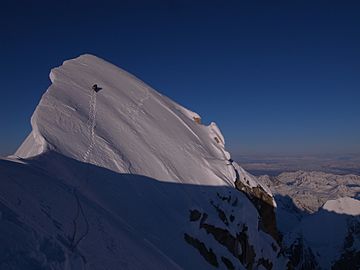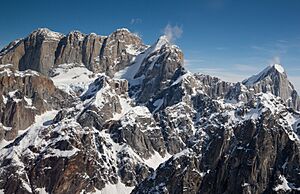The Moose's Tooth facts for kids
Quick facts for kids The Moose's Tooth |
|
|---|---|
 |
|
| Highest point | |
| Elevation | 10,335 ft (3,150 m) |
| Geography | |
| Location | Denali National Park and Preserve, Alaska, US |
| Parent range | Central Alaska Range |
| Climbing | |
| First ascent | June, 1964 by Welsch, Bierl, Hasenkopf, Reichegger (German) |
| Easiest route | Ham and Eggs: rock/snow/ice climb |
The Moose's Tooth is a famous mountain peak in Alaska. It is located in the central Alaska Range, about 15 miles (24 km) southeast of Denali. Even though it's not the tallest mountain, it is known for being very difficult to climb.
This mountain is special because it has many huge rock walls and long, icy channels called couloirs. These features make it a popular spot for experienced mountain climbers. They come here to try out very challenging climbs.
Contents
What's in a Name?
The Moose's Tooth was first called Mount Hubbard. It was named after General Thomas Hamlin Hubbard. He was the president of a group called the Peary Arctic Club.
However, the United States Geological Survey (USGS) later changed the name. They decided to call it "The Mooses Tooth." This name comes from the Athabascan people. It is a direct translation of their name for the peak. The official USGS name does not use an apostrophe.
Where is The Moose's Tooth Located?
The Moose's Tooth is found just east of the northern part of the Ruth Gorge. Across from it are mountains like Mount Barille and Mount Dickey. The Moose's Tooth is the main peak in a group of rocky mountains. Other peaks in this area have fun names like "Eye Tooth," "Sugar Tooth," and "Broken Tooth."
On the east side of this mountain group is the start of the Buckskin Glacier. This glacier helps climbers get to the very large and tough east face of The Moose's Tooth. Another way to reach the mountain is from the Root Canal. This is a flat, icy area on the south side where planes can land.
Why is it Called The Moose's Tooth?
The mountain gets its name from its unique shape. The top part of the mountain is a long, somewhat flat ridge. It stretches for about a mile from east to west. But on its north and south sides, the mountain drops very steeply.
This shape makes the mountain look a bit like a moose's tooth. Because of this long, flat top, it's very hard to reach the true summit from the west side. Most climbers reach the top by using the steep, icy channels on the southwest side.
First Climbs and Famous Routes
The first time anyone climbed The Moose's Tooth was in June 1964. Four climbers from Germany made it to the main summit. They used a path along the Northwest Ridge.
In June 1974, a team of four American climbers reached a lower summit. They climbed the Southwest Face. They found that the rock was not very strong in places.
A year later, in July 1975, Jon Krakauer, Thomas Davies, and Nate Zinsser made the second climb to the main summit. They used a path on the south face. They called this path the "Ham and Eggs Route." Today, this is the most popular way to climb The Moose's Tooth.
Notable Ascents
Many climbers have made amazing ascents on The Moose's Tooth. Here are some of the most famous climbs:
- 1964: Northwest Ridge to the main summit by Welsch, Bierl, Arnold Hasenkopf, and Reichegger (Germany).
- 1974: Southwest Face to the southwest summit by Gary Bocarde, Michael Clark, Charlie Porter, and John Svenson (USA).
- 1975: Ham and Eggs on the south face by Jon Krakauer, Tom Davies, and Nate Zinsser to the main summit.
- 1981: Dance of the Woo Li Masters on the East Face by Mugs Stump and Jim Bridwell.
- 1997: The Toose's Mooth on the north face by Seth 'S.T.' Shaw and Scott Simper.
- 2001: The Beast Pillar, a new start to the Dance route, by Jim Bridwell and Spencer Pfinsten.
- 2013: Bird of Prey on the East face by David Lama and Dani Arnold.
Images for kids





